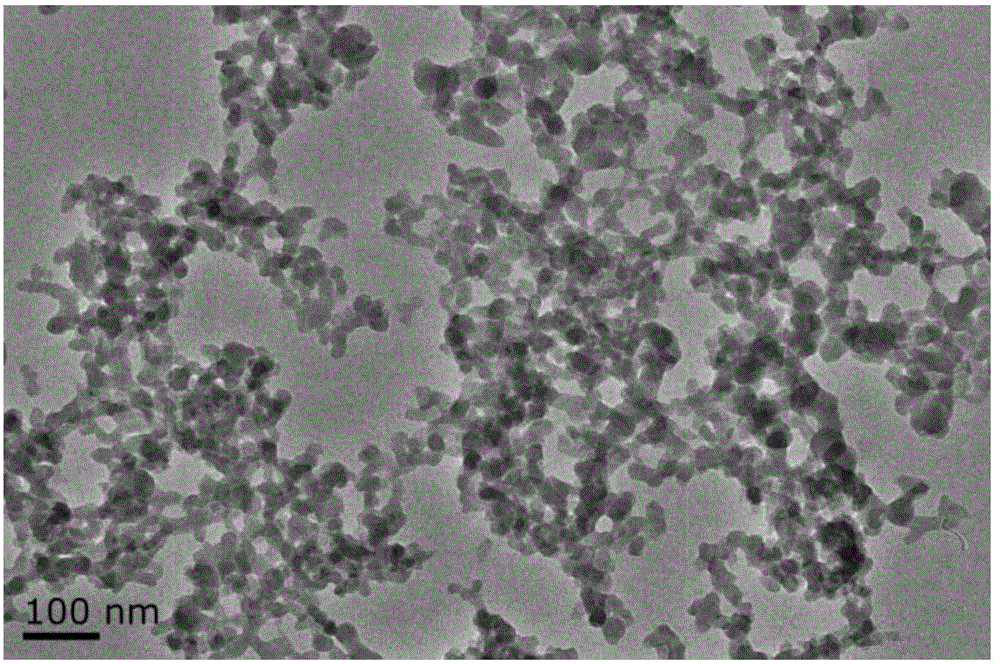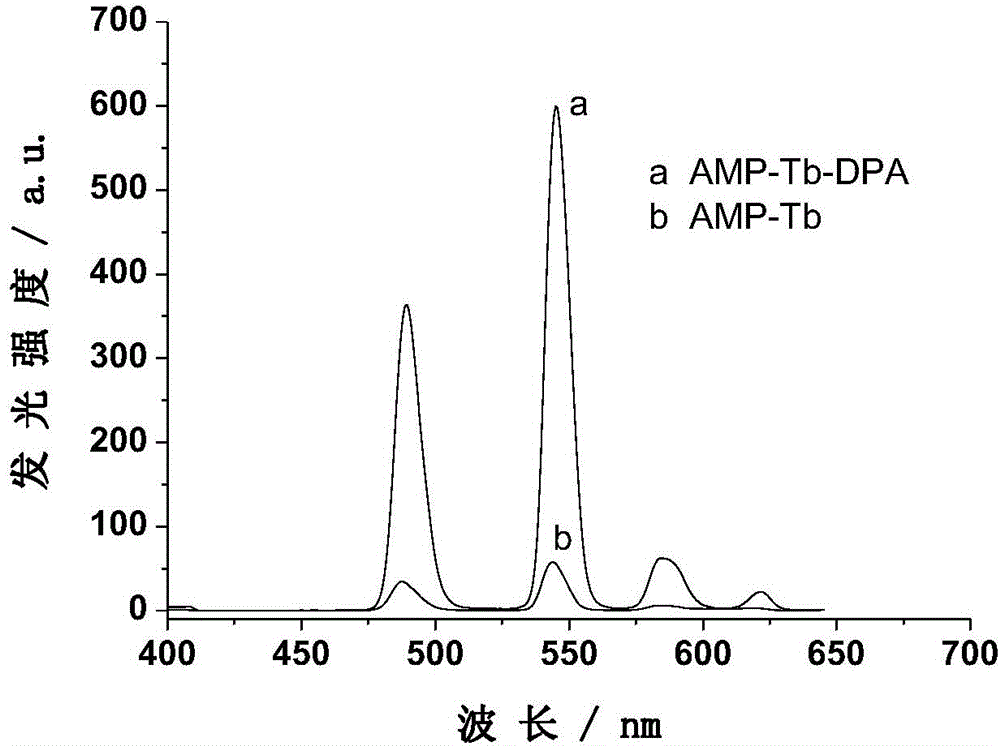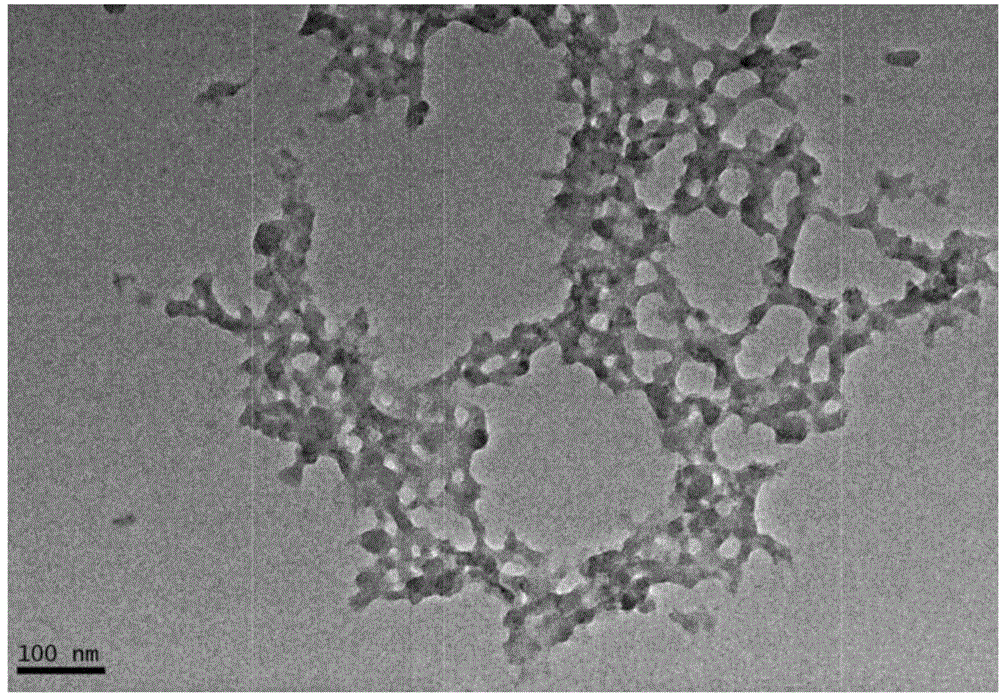Preparation method of nucleotide-rare earth coordination polymer light-emitting material
A technology of coordination polymers and luminescent materials, applied in luminescent materials, chemical instruments and methods, compounds containing elements of Group 3/13 of the periodic table, etc., can solve problems such as poor hydrophilicity and biocompatibility, and achieve Good hydrophilicity and biocompatibility, high luminescence intensity, avoiding the effect of complex synthesis
- Summary
- Abstract
- Description
- Claims
- Application Information
AI Technical Summary
Problems solved by technology
Method used
Image
Examples
Embodiment 1
[0024] Example 1: Preparation of adenosine monophosphate-terbium-pyridinedicarboxylic acid (AMP-Tb-DPA) coordination polymer
[0025] In 0.5mL N-2-hydroxyethylpiperazine-N'-2-ethanesulfonic acid (HEPES) buffer (100mM, pH7.4) containing 10mM adenosine monophosphate (AMP), add 0.5mL concentration of 10mM Tb(NO 3 ) 3 Aqueous solution and 0.5mL dipicolinic acid (DPA) aqueous solution with a concentration of 10mM produced a white precipitate. The solution continued to react for 3 hours under stirring, and the precipitate was collected by centrifugation (6000rpm×10min). The obtained precipitate was washed with deionized water and centrifuged. Separation, washing with deionized water was repeated three times, and finally, the precipitate was dried in an oven at 70°C, and stored in a desiccator after drying.
[0026] figure 1 It is the transmission electron microscope image of the prepared adenosine monophosphate-terbium-pyridinedicarboxylic acid (AMP-Tb-DPA) coordination polymer, ...
Embodiment 2
[0027] Example 2: Preparation of adenosine monophosphate-europium-tetracycline (AMP-Eu-Tc) coordination polymer
[0028] In 2 mL of N-2-hydroxyethylpiperazine-N'-2-ethanesulfonic acid (HEPES) buffer (100 mM, pH 7.4) containing 10 mM adenosine monophosphate (AMP), add 1.5 mL of 10 mM Eu(NO 3 ) 3 Aqueous solution and 0.5mL tetracycline (Tc) aqueous solution with a concentration of 10mM produced a white precipitate, the solution continued to react for 3 hours under stirring, centrifuged (14000rpm×10min) to collect the precipitate, the obtained precipitate was washed with deionized water, centrifuged, repeated Wash with deionized water three times, and finally, dry the precipitate in an oven at 70°C, and store it in a desiccator after drying.
[0029] image 3 It is a transmission electron micrograph of the prepared adenosine monophosphate-europium-tetracycline (AMP-Eu-Tc) coordination polymer, and the coordination polymer shows a network nanostructure. Figure 4 It is the flu...
Embodiment 3
[0030] Example 3: Preparation of adenosine diphosphate-terbium-phenanthroline (ADP-Tb-Phen) coordination polymer
[0031] In 1 mL of N-2-hydroxyethylpiperazine-N'-2-ethanesulfonic acid (HEPES) buffer (100 mM, pH 7.4) containing 3 mM adenosine diphosphate (ADP), add 1 mL of 3 mM Tb(NO 3 ) 3 Aqueous solution, then add 2mL of 1.5mM o-phenanthroline (Phen) aqueous solution, stir the mixed solution at room temperature for 3h, centrifuge at 10000rpm for 20min to collect the precipitate, wash the resulting precipitate with deionized water to remove unreacted reagents, centrifuge, Washing with deionized water was repeated three times, and finally, the precipitate was dried in an oven at 70°C, and stored in a desiccator after drying.
[0032] Figure 5 It is the transmission electron micrograph of the prepared adenosine diphosphate-terbium-phenanthroline (ADP-Tb-Phen) coordination polymer, and the coordination polymer shows a network nanostructure. Figure 6 It is the fluorescence sp...
PUM
 Login to View More
Login to View More Abstract
Description
Claims
Application Information
 Login to View More
Login to View More - R&D
- Intellectual Property
- Life Sciences
- Materials
- Tech Scout
- Unparalleled Data Quality
- Higher Quality Content
- 60% Fewer Hallucinations
Browse by: Latest US Patents, China's latest patents, Technical Efficacy Thesaurus, Application Domain, Technology Topic, Popular Technical Reports.
© 2025 PatSnap. All rights reserved.Legal|Privacy policy|Modern Slavery Act Transparency Statement|Sitemap|About US| Contact US: help@patsnap.com



